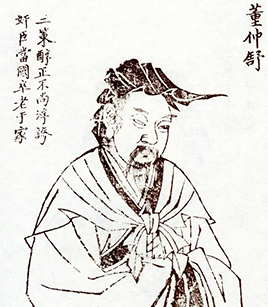Confucianism in Han Dynasty

FILE PHOTO: A Ming portray of Dong Zhongshu, an influential Confucian scholar of the Han Dynasty
Since the Spring and Autumn and the Warring States periods, rulers have oscillated between various ideologies of state governess. Legalism, Taoism, and Confucianism emerged one after another. The Qin Empire (221–207 BCE) emphasized the rule of law, attempting to suppress Confucianism by imposing a harsh legal system, and finally developed into tyranny, which led to its rapid collapse. Although the early Han (202 BCE–220 CE) inherited many practices of the Qin, it adopted a different ideology of governing the country.
In the early Western Han, in order to restore economic prosperity and social order, “Rule Through Non-action,” a Taoist principle that the ruler must respect the natural conditions of people and must not interfere unduly in their lives, but allow them to follow their own desires and ways to fulfill themselves, was implemented, supplemented by Confucianism and Legalism as the guiding ideology. It provided a relaxed environment for the rejuvenation of Confucianism.
During the rule of Emperor Wu of Han (r. 141–87 BCE), Dong Zhongshu’s proposal that Confucianism become the unifying ideology of the Han Empire was put into effect. As a philosopher, Dong made the theory of the interaction between Heaven (tian) and humanity (ren) his central theme. The emperor is Heaven’s ambassador on earth. He may reform institutions when necessary but may never alter or destroy the basic moral principles of Heaven. Dong took the deified “Heaven” as the highest existence, and built a huge Confucian ideological system in the Han Dynasty. However, this theoretical feature contributed to the emergence of chen-wei belief [divination combined with mystical Confucian belief], which not only deeply influenced political thought after the mid-Western Han, but also mystified the argumentation of the legitimacy of the monarchy’s rule in later generations.
Edited by REN GUANHONG
